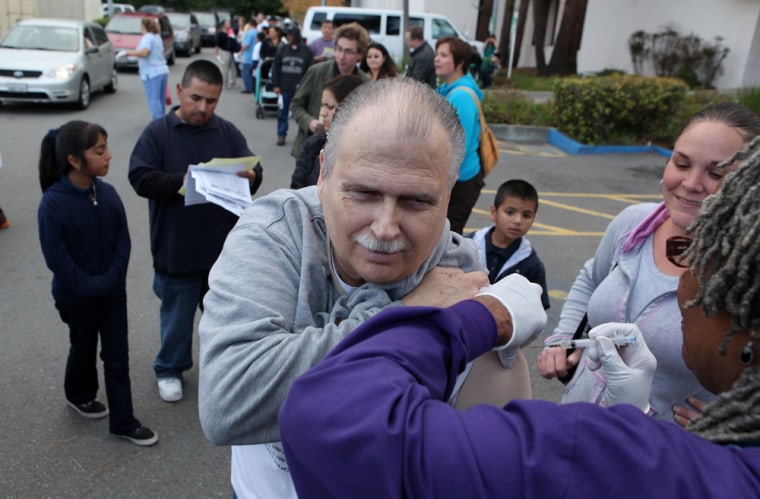Swine flu has caused nearly 10,000 deaths in the United States, part of an outbreak that has infected about 50 million Americans, government health officials said Thursday.
The deaths as of mid-November included about 1,100 children and 7,500 younger adults, said Dr. Thomas Frieden, director of the Centers for Disease Control and Prevention. About 200,000 people have been hospitalized, he noted.
The new estimates mean about 1 in 6 Americans has had the illness since the outbreak began last spring.
These numbers are a big jump from previous estimates, which said swine flu had sickened 22 million Americans and killed about 4,000 through mid-October.
Most of the increase is due to cases that occurred after early October, when the nation saw the peak of a second wave of illness, CDC officials said.
In recent weeks, the pandemic seems to have peaked in many places across the country. But Frieden noted that most of the population still has not been either infected or vaccinated against the virus.
"That still leaves most people without immunity," Frieden said.
Tricky estimates
While the elderly account for most of the hospitalizations and deaths from seasonal flu, the largest proportion of reported swine flu hospitalizations and deaths are in non-elderly adults, CDC officials said.
More than three-quarters of the deaths were people ages 18 to 64, according to the CDC.
The new estimates seems to echo an unpublished, in-depth CDC analysis of 100 U.S. swine flu deaths. About 80 percent of those deaths were in people ages 20 through 59, and 45 percent were obese, that research found.
Flu estimates are tricky and inexact because many illnesses are relatively mild and go unreported, and hospitalizations and deaths often involve maladies beyond the flu. The CDC actually thinks that between 34 million and 67 million Americans have gotten sick from swine flu, but Frieden gave 50 million as a midpoint estimate.
Flu estimates are also difficult to compare. Seasonal flu kills about 36,000 Americans each year, according to a long-standing estimate. But that number includes many elderly people who had not only seasonal flu and related pneumonia but also heart attacks and strokes. The new CDC swine flu estimates do not include heart attacks and strokes, mainly because there hasn't been time to collect that kind of data.
So it's likely the new estimate is conservative, and undercounts elderly deaths, CDC officials acknowledged.
Even so, the number of hospitalizations and deaths of younger people from swine flu far exceed what normally occurs in the same ages from the winter flu.
"This flu is much harder on younger people," Frieden said.
Two waves
The swine flu pandemic has so far hit in two waves in the United States: First in the spring when it was first identified, then a larger wave that started in the late summer.
In late October, 48 states reported widespread flu activity. Increasingly, that appears to have been the peak of the second wave. Since then, fewer states have been reporting widespread cases, and the number of school closings due to swine flu has at times dropped to zero.
But there are still plenty of ill people — as many as during the worst days of many regular flu seasons. And CDC officials have said the signs of declining cases do not necessarily mean the worst is over.
Swine flu vaccine first came out in early October in very limited supplies. But deliveries are increasing dramatically, and now about 85 million doses are available.
Also on Thursday, the CDC released a study that found American Indians and Alaska Natives have died from swine flu at a rate four times greater than other Americans.
The study looked at swine flu deaths in 12 states that are home to about half of the nation's American Indians and Alaska Natives, and counted 42 people in those groups who died of swine flu or its complications by mid-November.
That was a rate of nearly 4 out of every 100,000 people for that group, compared to a rate of about 1 per 100,000 for everyone else.
The finding was not surprising. American Indians and Alaska Natives have higher rates of diabetes, asthma and other conditions that make them more vulnerable. The two groups also have higher poverty rates, and were hit harder than other people during past flu pandemics.
In a separate report, also out Thursday, the British Health Department estimated that out of every 100,000 infected people in Britain, about 26 died. That's about 100 times less deadly than the devastating 1918 Spanish flu.
